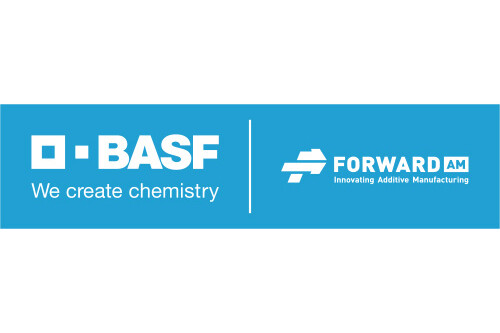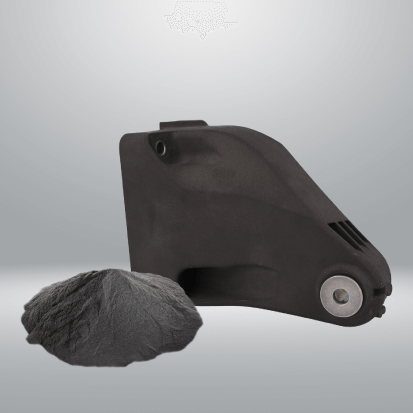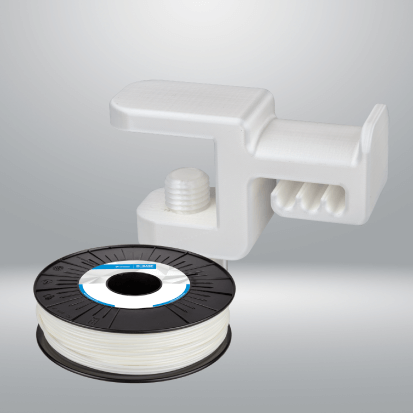
BASF's Forward AM is a leading provider of innovative 3D printing solutions, offering a comprehensive range of high-performance materials and services tailored for various industries. As part of the global BASF Group, Forward AM combines extensive expertise in chemistry and manufacturing with cutting-edge additive manufacturing technology. Their portfolio includes advanced filaments, powders, and resins designed to meet the most demanding requirements in sectors such as automotive, aerospace, and consumer goods. Committed to driving industrial progress, Forward AM supports customers with end-to-end solutions that enhance efficiency, sustainability, and product quality.

.png)

Click on a material to learn more.
Ultrafuse® ABS Fusion+ is an easy-to-print engineering material and enables a much more efficient printing process. Meaning 3D printing operators will spend less time tinkering and more time exploiting the full potential of your 3D printing rig. To top it off, Ultrafuse® ABS Fusion+ adheres to water-soluble support – no more hassle with chemicals, just dissolve your support in water after printing! Thanks to the unique properties of ABS Fusion+ you can look forward to a high success rate with greatly improved dimensional stability.
Ultrafuse® PA6 GF30 is a unique compound specifically developed for FFF printing. Due to the glass fiber content of 30%, parts tend to warp less. In addition the excellent layer adhesion and its compatibility with the water soluble support Ultrafuse® BVOH make this material the perfect solution to develop industrial applications on an FFF printer. With its high wear and chemical resistance, high stiffness and strength, Ultrafuse® PA6 GF30 is perfect for a wide variety of applications in automotive, electronics or transportation. Ultrafuse PA6 GF30 is designed for functional prototyping and demanding applications such as industrial tooling, transportation, electronics, small appliances, sports & leisure.
Ultrafuse® PC GF30 is a unique compound of PC with 30% glass fibers, specially designed for FFF printing. With its high heat deflection temperature and good dimensional stability, Ultrafuse® PC GF30 is the right material to use in an industrial environment where good temperature resistance and high strength is needed. Its UL94 V0 rating makes PC GF30 the perfect solution for applications in transportation industry that require flame retardancy. The resistance to UV light exposure and its low moisture uptake makes Ultrafuse® PC GF30 highly suitable for interior and exterior applications.
Ultrafuse® PET CF15 is a functional filament with high dimensional stability and low moisture absorption, ideal for humid environments. The PET and carbon fiber blend creates a lightweight, robust, and durable material with excellent heat resistance up to 74°C. This filament can be printed on most non-proprietary FFF 3D printers. Due to its abrasiveness, it is recommended to use hardened steel or ruby nozzles. Its heat resistance, strength, and rigidity make Ultrafuse PET CF15 perfect for various industrial applications.
Ultrafuse® PET is made from a premium PET and prints as easy as PLA, but is much stronger. The filament has a large operating window for printing, so it can be used on every 3D-printer. PET will give you outstanding printing results: a good layer adhesion, a high resolution and it is easy to handle. Ultrafuse PET can be 100% recycled, is watertight and has great colors and finish. Ultrafuse® PET is based on food-safe raw materials (granulate), which are suitable for food contact applications according to the European Plastics Regulation.
The “r” stands for recycled, as Ultrafuse® rPET is made from recycled PET post industrial waste. Components printed with Ultrafuse® rPET print, look and perform as outstandingly as our PET filament made from virgin raw material. Ultrafuse® rPET is based on food-safe raw materials (granulate), which are suitable for food contact applications according to the European Plastics Regulation.
Ultrafuse® PLA PRO1 is developed as a high-speed engineering thermoplastic that prints as easy as PLA, at speeds previously considered unusable. Yet it retains far better mechanical properties, that even exceed printed ABS objects. Something that the most demanding users have always had to make a compromise on prior to Ultrafuse® PLA PRO1. By varying the print settings, users can optimize for speed, strength, surface quality or a mix of those qualities beyond performance levels of traditional filaments. Ultrafuse® PLA PRO1 has strong layer adhesion which makes prints much stronger, thus increasing functionality.
Ultrafuse® PP is high-performance thermoplastic with low density, high elasticity and high resistance to fatigue. The mechanical properties make it an ideal material for 3D-printing applications which have to endure high stress or strain. The filament has high chemical resistance and a high isolation value.
Ultrafuse® TPS 90A is an elastomer based on the raw material SEBS. The combination of durable and flexible building blocks leads to a very versatile material. Compared to other flexible 3D printing materials it shows more rubber-like soft touch haptics and better non-slip properties. Furthermore, the material shows a reduced moisture uptake, which allows for printing without pre-drying. Parts printed with Ultrafuse® TPS 90A show almost no visible layers or warpage, which makes it an excellent material choice for end-use parts.
Ultrafuse® TPU 85A filament is a flexible material, offering cushioning and durability. With excellent mechanical and chemical properties, it ensures optimal reliability, making it ideal for professional applications in footwear, sports, industrial manufacturing, automotive, and construction.
With its outstanding abrasion resistance, Ultrafuse® TPU 95A presents an excellent choice for wear and tear applications. Parts printed with this material set themselves apart by high elongation at break, great layer adhesion and a good resistance to oils as well as industrially used chemicals. Ultrafuse® TPU 95A comes with a well-balanced profile of flexibility and durability. On top of that, it allows for easier and faster printing then softer TPU grades. Due to its good printing behavior, Ultrafuse® TPU 95A is a good choice for starting printing flexible materials on both direct drive and bowden style printers.
Ultrafuse® TPU 64D combines the best of two worlds by being a strong yet flexible filament for Fused Filament Fabrication, suitable for all FFF technologies. This material is based on the established thermoplastic polyurethane Elastollan, standing for maximum reliability, consistent product quality and cost efficiency. Ultrafuse® TPU 64D is easily compatible with water soluble support. Thanks to its property profile, Ultrafuse® TPU 64D presents an excellent alternative to rubber and ABS for the manufacturing of tools, jigs and fixtures. Ultrafuse® TPU 64D is easy to print on direct drive and bowden style printers and is compatible with soluble BVOH support to realize the most complex geometries. Ultrafuse® TPU 64D is based on food-safe raw materials (granulate), which are suitable for food contact applications according to the European Plastics Regulation.
This stainless steel can be fully heat treated to high levels of strength and hardness. With good corrosion resistance and a wide range of post-processing options for green parts, it is therefore ideal for petrochemistry, aerospace, and automotive applications.
Ultrafuse® 316L combines greater freedom of design with a low total cost of ownership. As a filament, Ultrafuse 316 L is 80% stainless steel and has a 20% polymer content which allows for easy printing on many open FFF desktop printers.
Ultrasint® AP26 is a material especially developed to combine affordability with printed part performance and outstanding processability on and PBF equipment. Its lower melting temperature compared to other PBF materials allows for a processing temperature of 150-160 °C. Printed parts fulfil most requirements from form & fit prototyping to high-volume series parts. AP26 boasts of a very high dimensional stability, precise detail resolution, smooth surface as-printed and very high stiffness and rigidity – making it the material of choice for advanced prototyping and beyond.